As an Amazon Associate I earn from qualifying purchases.
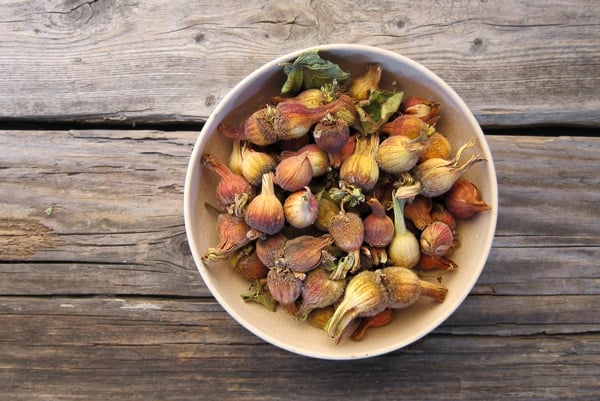
One of the more amusing things about foraging is that you can covet a certain plant for years and years, but never find it. Then, when you finally do, you start to see it everywhere. This was the year I cracked the code on how to harvest hazelnuts, Corylus cornuta, in the wild. What makes harvesting wild hazels so hard? Glad you asked. I’ll tell you.
First, you don’t harvest hazelnuts in traditional nut season (read: autumn). Nope, hazelnuts come ripe in high summer here in California, or late summer in most other places. If you wait until late September, when most other nuts are ripening, you’re too late. I pick most of my hazels at the end of July and in early August.
Which brings me to the second problem. Finding hazel trees. Lesson One: Hazelnuts don’t grow on trees. They grow on shrubs. Rarely will a hazel grow past 15 feet high, and eight feet or less is pretty much the rule here. So you don’t want to look up to spot hazels.
(Keep in mind I am writing here solely about the beaked hazelnut, not the American hazelnut, which does not grow in California.)
In fact, you need to look down, or rather under. Hazels hide their nuts underneath their leaves, so harvesting them is a matter of moving around the branches and spotting the funny-looking beaky sheaths that enclose them.
But I’m getting ahead of myself. First you need to know where you might find beaked hazelnuts. In California, you will find hazelnuts only in Northern and Central California, on the coast, the Sierra Nevada or in the Sisykous. Beaked hazelnuts also can be found in western Washington and Oregon, in much of Canada, Minnesota, Wisconsin, northern Michigan, New York, all of New England and pretty much the entire Appalachian Mountain Range.
Now you need to identify the plant.
We’ve established that it’s a shrub. Hazels like to live kinda-sorta near moisture, but not right on riverbanks. I tend to see them near little streams and on roadsides. They also grow close to the shoreline on the Pacific Coast. They don’t look like much. They have a pretty typical leaf pattern, but look for the toothed edges and the fact that hazel leaves are fuzzy. The leaves also alternate like you see in the picture.
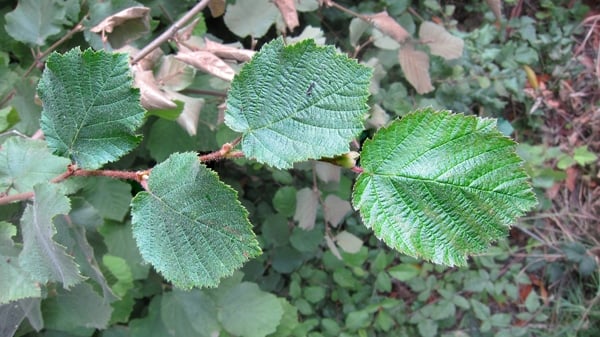
You may also see the male flowers, called catkins, on the plant as well. Incidentally, grouse and quail love to eat these.
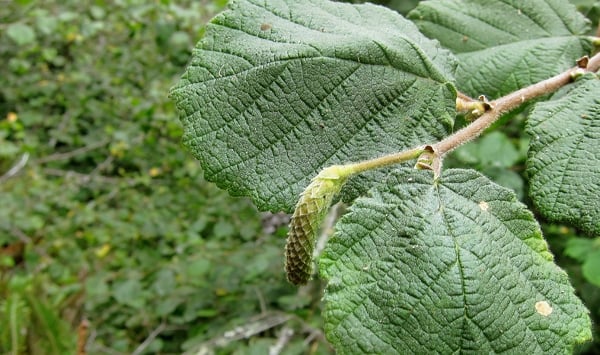
Start scoping out for unripe nuts around Independence Day. Start checking them toward the end of July and into August. You are looking for the nut sheath, called an involucre, to be mostly still green but with patches of color, ranging from rosy red to brown. Nothing else looks like a hazelnut, so there are no poisonous lookalikes to worry about.
Typically beaked hazels set single nuts, but doubles are pretty common. I’ve found quite a few triples and a few quadruples. My friend Sam Thayer says he’s found up to nine nuts in one cluster! Pick the clusters by twisting them off. Don’t break the twigs.
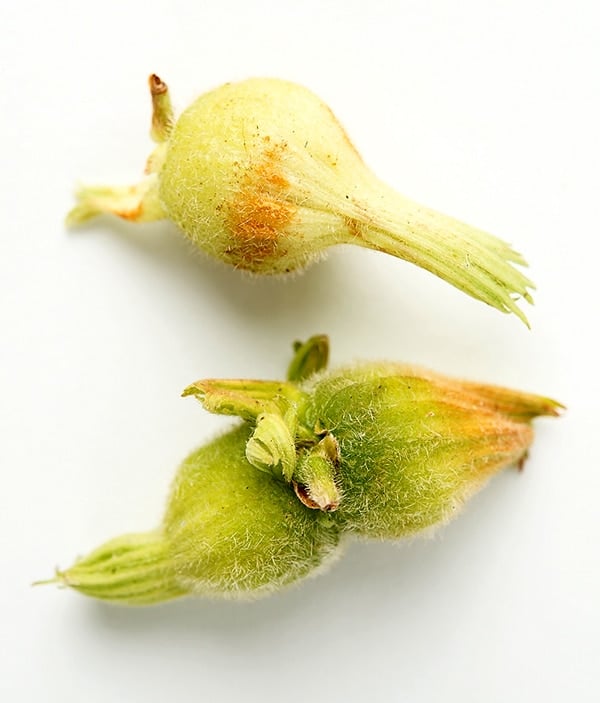
Now I ought to tell you that the involucres of beaked hazelnuts are covered in little fuzzy spines. They are not as bad as the hated glochids of prickly pears, but if you have soft hands you may want to wear gloves. I don’t, and yes, my hands bother me for a few minutes after I am done picking, but it goes away quickly.
Once you get home with your hazelnuts, you need to let the involucres dry out. I put the nuts in a big hotel pan in my garage to dry. They key here is to spread the nuts out in a thin layer — I’d say no more than two nuts deep. If you stack them too deep the ones on the bottom won’t dry as well, and if you live in a place where it isn’t arid, as it is here in NorCal, they could rot on you.
I left mine to dry for a couple weeks. This gives any nuts I might have picked too early a chance to ripen. Picking some nuts that are unripe is an occupational hazard, but if you wait until at least the end of July to pick (in California) you should be OK. You’ll know if the nut was unripe when it comes time to husk them: The husk sticks to the top of the nut.
Does this mean you need to toss the nut? Nope. But eat those hazelnuts first, as they will not store as long.
To husk the nuts, I just tear off the involucre with my hands. The hazelnut should roll right out. Yes, you will get the little pines all over your hands. Deal. Or wear gloves. There is no other good way to husk them in a dry climate. Sam, however, lives in Wisconsin. His technique will work if you live in a wet place: He buries his hazelnuts in mud for a month. When he digs them up again, the involucres are all black and rotted, but the nuts are just fine.
Keep in mind that wild hazelnuts aren’t as large as the domesticated filberts you buy in the store.
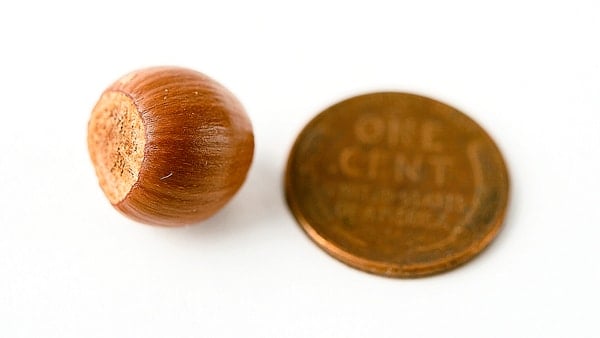
Once they’ve been husked, hazelnuts last for a long, long time in the shell. I’ve eaten 18-month-old nuts that tasted fine. When you are ready to eat them, just crack and eat. Or if you want to roast them, crack and lay the nuts in a single layer on a baking sheet and bake at 275°F. for 15 to 20 minutes. Don’t let them scorch, so watch them after 10 minutes or so. If you want to remove their skins, wrap warm hazelnuts in a kitchen towel and let them sit for 10 minutes. Rub off the skins in the towel.
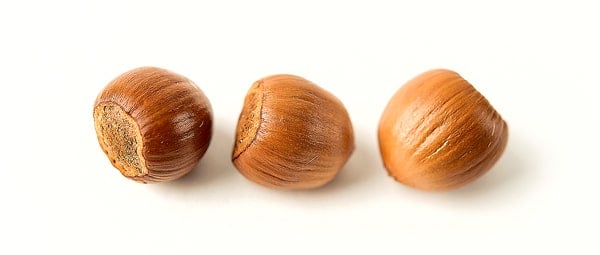
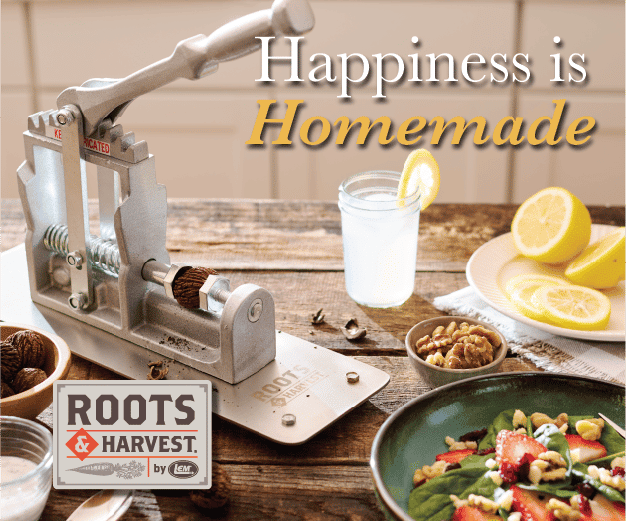

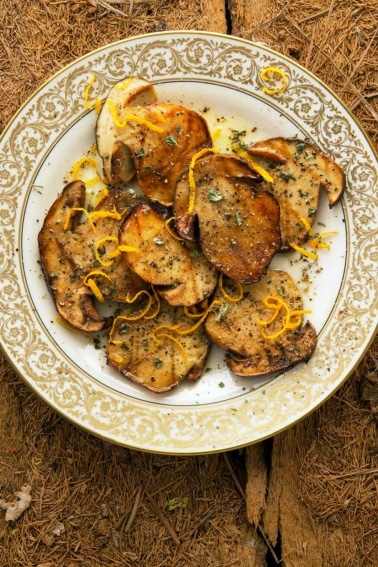

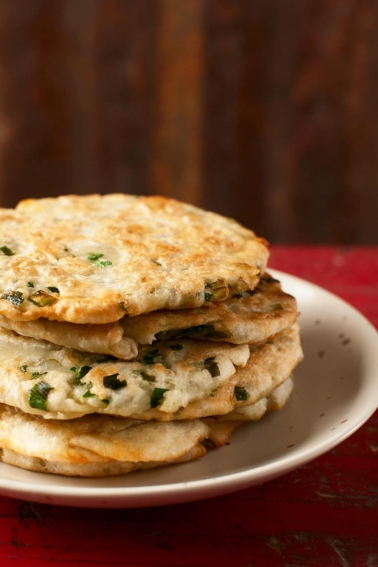
We also live in Olympia, WA with a lot of hazelnut bushes. I’ve used them for decades for various things. The nuts I’ve taken on bike tours to be cracked with small “vice grips” for snacking when taking a breather.
The suitable sized shoots, I’ve peeled in the spring, and used as “Thumb Sticks” for a third leg when wading fast trout streams, with my thumb secured in a suitable fork. The wood is a beautiful pale white and quite hard, and it seasons well with only a little cracking. The branch forks I’ve joined together with a lap joint with epoxy and a copper rivet to form teapot handles, as I was a studio potter for a number of years. A lot of work, but no one else was doing it. (They probably had better sense!) Check out William Butler Yeats poem”Song of the Wandering Aengus.”……” I went into the hazel wood because a fire was in my head…..”
I also have a Facebook page: YARNS FOR RUMENATION
We have been picking the beaked hazelnuts in Olympia, WA the last few years. They are abundant around the outer, sunny part of a trail we walk in our neighborhood that backs up to wetlands. We definitely have to pick the last week of July or early August or the wildlife have beat us to them. For every one we pick, we leave two for the animals!
Those BUCK TOOTHED little varmints will usually get the majority of them and leave all the shells on your driveway/sidewalk! You walk on those shell fragments and they come off in the carpets!!!^*#_*~*`!!!
The hazelnuts in my northern Minnesota woods, many of them, have little worms inside. Anyone else run into that?
Yes mine have worms too. Callaway MN
Also in Minnesota, by Hinkley, I picked a bunch and let them dry. When I went to open the shell they all had a worm hole in them and no nut remaining. The little bugged ate the nut then escaped.
I grew up in central Wisconsin in the 1970’s. My gran had a trailer in the woods with hazelnut bushes everywhere. My sisters and I would spend our fall afternoons picking hazels until our held out shirts were full. They would each have up to five nuts. We never new there was a proper technique we just waited a couple days then pulled the skins off. Cracked them and ate them. They are extra delicious oven toasted and still warm. Thanks for tugging at a wonderful memory. If I wish to plant bushes, how old must they be before they produce nuts?
We just moved from Northern Cali to the Willamette valley. We live on a stream and river . I didn’t know what these strange wrapped nuts were until I opening the wrapping and found your site ! What a wonderful surprise ! The tree/shrub I found it on was a cluster of small long branches 10’-15’ high, next to our creek . We were trimming it back from our garden fence thinking it was the local brush . When I found the nuts, I wanted to cry ! Hopefully we didn’t trim it too much . Now that I know we have them , I can’t wait to look for more on our property . Thank you for the info ..
The trees in South Seattle don’t have nuts….why?
Sylvia: Chances are they do, and you’re missing them because they can be hard to spot. They are under the leaves. Also, look for them in early August.
I found a tree in Seattle a couple years ago and every nut was a dud. Just moved to Burien and found a tree on our property. Some green ones are already falling. I found a few online discussions and recipes. Do you ever eat the early fallen green hazelnuts? A bit acrid, green, and milky tasting. Not something I’d eat a lot of without altering sonehow.
I’ve been looking for these for about 15 years. I finally found a bush of them today and then I found them everywhere I looked. I was on a trail that I’ve been walking on for about 15 years! I’ve never seen them before. I picked a whole lunch bag full and will go back for some more.
Thanks for the information about collecting and storing and roasting. I live north of Lake Superior about 1 hour into the bush and I harvested some husks that were mostly green to yellow and some with brown. I tried to husk a few, no problem. Can’t wait until I can husk and eat these.
I also live in Wisconsin, thanks for the great article writing & teaching the correct way to harvest Hazelnut. My wild bushes are ripening now, i forge alot of yummy things nature gives us, what a great gift from Mother Nature.
Thank you! After years of bringing home and planting a single hazelnut from each fall hike on which I found them, I have California hazels all over my back yard, and this year they are finally producing nuts—lots of them! This was just the info I needed. Hoping the squirrels don’t nab them while I’m waiting for the end of July! :O
There is a much much better way to remove the husks. You get some sort of tough bag, burlap or a dog food bag or even a contractor trash bag. Make sure the husks are sufficiently dried, I put mine in the back of a car for a few days, then you put them in the bag and walk on them on a concrete floor with shoes. They pop out if the husks for the most part.
I just picked some for the first time. saw them last year but did not know what they were. Have been drying them in the sun and taking them in at night for a while. Rained a few days so kept them inside. Covered them with towels so the wild life mice, etc would not get to them. I think they will be ready soon.
When can you harvest in northern illinois/southern wisconsin the grey squirrels always beat me to them.
Thanks
Dale: Any time now, I’d think.